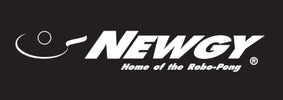SETTING UP A TABLE TENNIS ROOM
By Larry Thoman
This column will consist of questions that have been asked of the staff at Newgy or our replies to questions posed on the table tennis newsgroup, rec.sport.table-tennis. This month's question was posed by Dave Shook on the TT newsgroup. We encourage readers to send in your own questions. You may email us at expert@newgy.com or fax orwrite us. All questions cannot be answered, but every month we will pick out one of them to answer in this column.
Question:
I just moved into a new house and plan to put a table in the basement. The room is 17' wide and 22' long, so I already know from the recent posting on "space needed for a table" that it should be larger, but that was the best I could do. Anyway, I need to install lighting and the obvious choice for a novice like myself would be fluorescent lights. Any other recommendations? Track lighting?
Answer:
Dave,
It's great that you've decided to add a Table Tennis Room (TTR) to your house. Your room dimensions are very similar to the TTR in my house. As is typical in many American homes, these are the average dimensions of a two car garage, which can be converted into a decent table tennis room.
To situate your light fixtures, I would start with one mounted in the center of the room directly over the center of the table when it is positioned in the center of the room. Then I would add lighting going towards each of the 17-foot walls. Recessed light fixtures are best, but commonly, most converted garages will dictate surface mount fixtures because of the ceiling height and the direction of the ceiling joists.
In situating the lighting, give priority to positions close to or over the table, where the majority of rallies will take place. Lighting close to the wall is less critical because your body will be taking up space in front of the walls in addition to the space required for your backswings. Your eyes will be 2 to 3 feet away from a wall even when your "back's against the wall".
As a minimum, I would suggest at least one 4-foot double tube fluorescent fixture centered above the table net and another similar fixture centered with the table about 2 feet in back of each endline (See Layout A). All fixtures are parallel with the endlines of the table. Fixtures should be shielded by an opaque covering to prevent glare from direct eye contact with the bulbs.

To improve on this minimum, 4-tube, 4-foot or 2-tube, 8-foot fixtures could be substituted. The 4-tube fixtures will concentrate more light over the table, while the 8-foot fixtures will spread out the light more evenly across the entire room. Another option would be to add 2 more fixtures (Layout B). In this case you could have one fixture in the center, 1 at each end of the table and 1 lighting up the playing areas in back of the table. This would be ideal.

Also with only 22 feet of room, it will be difficult to play a competitive match without feeling quite hindered (only 6.5 feet of backup room for each player). That is however, an ideal amount of room for robot play. With a 9 foot table and approximately 1 foot for the depth of the robot attached to the end of the table, you would have 12 feet of backup room to practice strokes and footwork relatively unhindered if you push the table up against a wall.
I'll give you one more tip here too, although it has nothing to do with the lighting. If you have a choice of flooring, go with wood. One of the least expensive wood floors is a wood parquet floor. Home Depot and Lowes have wood parquet flooring for under $2.00/sq. ft. This is cheaper than many linoleum flooring materials. This is what I used for my TTR 3 years ago and I've been extremely happy with it.
Happy Ponging!






Add a comment